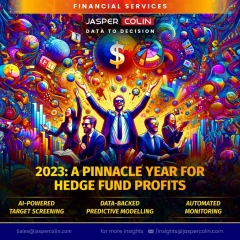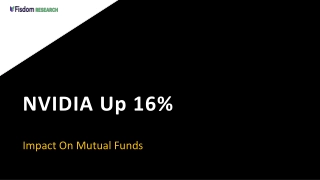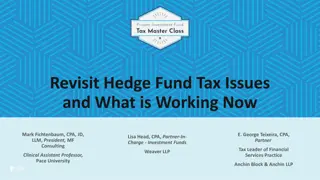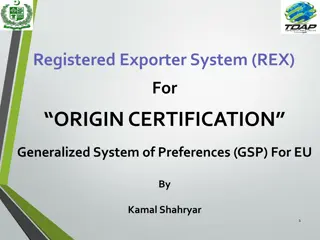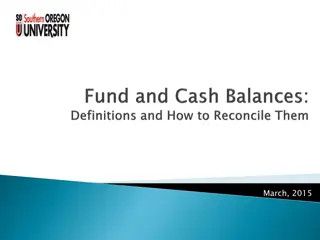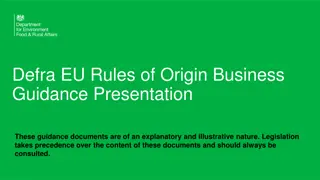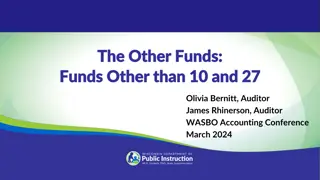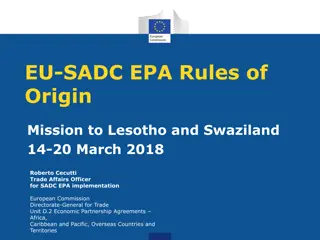Origin of Hedge Funds and MMT's Economic Principles
Hedge funds began with relative value sovereign bond trades, while Modern Monetary Theory (MMT) emphasizes government as the supplier of jobs for full employment. MMT challenges traditional economic norms, advocating for deficit spending and disregarding the need for balancing budgets. It integrates elements of Keynesian fine-tuning and explores government budget autonomy. However, it has deviated from its Employment of Last Resort (ELR) foundation in addressing economic challenges like stagflation.
Download Presentation

Please find below an Image/Link to download the presentation.
The content on the website is provided AS IS for your information and personal use only. It may not be sold, licensed, or shared on other websites without obtaining consent from the author.If you encounter any issues during the download, it is possible that the publisher has removed the file from their server.
You are allowed to download the files provided on this website for personal or commercial use, subject to the condition that they are used lawfully. All files are the property of their respective owners.
The content on the website is provided AS IS for your information and personal use only. It may not be sold, licensed, or shared on other websites without obtaining consent from the author.
E N D
Presentation Transcript
MMT How Did it Start?: Hedge Funds It started as a relative value sovereign bond trade Buy at a discount to certain final par value Fund in low interest market Wait for price to converge to maturity: take profit and repay loan Only credit risk government default No Government Bond Default on Own Currency Sovereign Debt Sovereign Debt Hedge fund Arbitrage traders Government (eg Italy) will not default on Sovereign Debt Short DM, Long High Interest Rate Lira, Low rated, discounted debt Withholding tax mispricing See III & John Meriwether (later founded LTCM) at Solomon Brothers & Others
UMKC CFEPS Employer of Last Resort Centre for Full Employment and Price Stability no MMT here Funded by Warren Mosler University of Missouri Kansas City Director Mat Forstater From The Mosler Business Card Economy to UMKC Buckaroos Government as Supply of Jobs to ensure Full Employment Government a Dealer in Jobs In financial markets dealers set bid-ask prices Willing to buy and sell at those prices Need Capital to keep reserves to be able to sell at ask price Government jobs are the reserves to keep wages in bid-ask range A buffer stock of jobs (also proposed independently by Bill Mitchell) What is the government s capital ? Deficit Spending to fund the stock of government jobs Econometric estimates {e.g.Scott Fulwiler} of 1-2% of GDP No Default principle implied no limit on government capital
The MMT Tail (fiscal policy) Wags the ELR Dog (price stability) No Default principle then produced the reply to deficit Hawks No need to fund deficit by issuing government bonds No need to tax to finance expenditure But tax liability to drive demand for government debt No Need to Balance Budget Lerner Functional Finance Knapp State money Lerner State money Fiscal policy (tax/expenditure policy) to control demand and inflation ELR assured full employment Bond issuance to produce interest rate target This became MMT sovereign government budget autonomy {looks a lot like neoclassical synthesis Keynesian fine tuning} BUT it lost sight of the ELR as an answer to Friedman s Reconsideration of the Quantity Theory as represented in Expectations Augmented Phillips Curve as an answer to stagflation
Is Fiscal Policy Autonomy the focus of Keynes GT?: Minsky No Is Fiscal Policy Autonomy the focus of Keynes GT?: Minsky No
The Conundrum of Stagflation: Phillips Curve The Conundrum of Stagflation: Phillips Curve Keynes theory presented in IS-LM had no explicit micro pricing so was considered as being in real terms It was compatible with supporting government demand management in the form of fine tuning of real expenditures, but missing any microeconomic analysis of markets and prices. But it was the emergence of inflation in the late 1950s and then with greater force in the end of the 1960s along with unemployment producing the conundrum of stagflation that made the absence of prices obvious The more acceptable response to this dilemma was to accept the empirical relations established by Phillips (1958) and then Samuelson and Solow (1960), suggesting that there was a choice or a policy trade-off to be made between inflation and unemployment supported fiscal policy measures up to a limit of an acceptable rate of inflation Eventually the Phillips curve is appended to the IS-LM model to explain price inflation!
Friedman provided alternative solution to the Explanation of Prices and Inflation: Friedman provided alternative solution to the Explanation of Prices and Inflation: A Reconsideration of the Quantity Theory A Reconsideration of the Quantity Theory Positive Economics: No need for theory, a good correlation is sufficient as a basis for policy to fight inflation. 1948: A long-term government policy setting a monetary framework (MF) for a competitive order since the competitive order cannot provide one for itself. It should operate under the 'rule of law" rather than the discretionary authority of administrators. Read Deep State . The MF would eliminate both the private creation or destruction of money and discretionary control of the quantity of money by central bank authority. To complete the elimination of the major weapons of discretionary authority, the existing powers to engage in open market operations and the existing direct controls over stock market and consumer credit should be abolished. Government would set a full employment budget and an actual budget setting stable (progressive) tax and expenditure policy to balance the former while deficits in the latter would generate automatic stabilizer expenditures financed by direct money creation. Eliminates discretionary government anti-cyclical demand management policy.
Expectations and the Phillips Curve Expectations and the Phillips Curve To compliment the Long term MF in the presence of record inflation levels in the 1960s, Friedman s AEA 1968 Presidential address turns to short-term monetary policy. If the monetary authority tries to peg the "market" rate of unemployment at a level of 3 per cent (that is below the "natural" rate), when prices and wages have been stable and level and expectation of real and nominal wages and prices are stable the authority increases the rate of monetary growth making nominal cash balances higher than people desire, Income and spending will take the form of an increase in output and employment rather than in prices. Producers will tend to react to the initial expansion in aggregate demand by increasing output, employees by working longer hours, and the unemployed, by taking jobs now offered at former nominal wages. Mismatch in Price expectations: But it describes only the initial effects. Because selling prices of products typically respond to an unanticipated rise in nominal demand faster than prices of factors of production, real wages received have gone down- though real wages anticipated by employees went up, since employees implicitly evaluated the wages offered at the earlier price level. Indeed, the simultaneous fall ex post in real wages to employers and rise ex ante in real wages to employees is what enabled employment to increase. But the decline ex post in real wages will soon come to affect anticipations. Employees will start to reckon on rising prices of the things they buy and to demand higher nominal wages for the future. "Market" unemployment is below the "natural" level. There is an excess demand for labor so real wages will tend to rise toward their initial level. Even though the higher rate of monetary growth continues, the rise in real wages will reverse the decline in unemployment, and then lead to a rise, which will tend to return unemployment to its former level. In order to keep unemployment at its target level of 3 per cent, the monetary authority would have to raise monetary growth still more. As in the interest rate case, the "market" rate can be kept below the "natural" rate only by accelerating inflation. Thus, not only does money remain a veil, it only has an impact on economic activity by hiding the evolution of real variables from economic agents; instead of a tool of stabilization it will do just the opposite. The counter-intuitive result is that all monetary policy can do is avoid causing instability by avoiding active monetary policy and unifying real and monetary representation of economic variables. That is price stability.
BUT: Friedmans Analysis is Fatally Flawed BUT : Friedman s Analysis is Fatally Flawed If after the increase in the money supply hours worked are higher, and the unemployed are accepting work, then they must have already been involuntarily unemployed, i.e. they were previously willing but unable to work at the previously existing real and nominal wages since prices have not changed and expectations have not changed from the initial position before expansion from the natural unemployment! This implies the assumption of initial conditions in which there is involuntary unemployment when unemployment is at the natural rate. But, if this is the case there can be no reason for goods prices or wages to rise until full employment is achieved, since there was no initial excess demand for labour. It would appear that Friedman implicitly intended to argue (not surprisingly) that the natural rate of unemployment was equivalent to full employment! It is puzzling to find it put forward as a discovery that a higher inflation rate will not increase the full-employment level of employment: Keynes and Keynesians would not have claimed otherwise. In fact, the world described quite plainly needs no macro-policy. Keynesians were concerned with the problem of pushing the economy to its natural rate, not beyond it. If the economy is there already, we can all go home. (1982, 74-5)
Provide a Policy of Price Stability or a response to deficit Hawks/Treasury View? The definition of monetary sovereignty which is found widely among literature influenced by modern monetary theory (MMT) focuses on the issuance of a national currency alongside taxation and government financing denominated in that currency. 1. the National government chooses a money of account in which the currency is denominated; 2. the National government imposes obligations (taxes, fees, fines, tributes, tithes) denominated in the chosen money of account; 3. the National government issues a currency denominated in the money of account, and accepts that currency in payment of the imposed obligations; and 4. if the National government issues other obligations against itself, these are also denominated in the chosen money of account, and payable in the national government's own currency. The latter condition means that the government does not incur debt denominated in foreign currency. According to Wray, a fifth, important consideration" is 5. to have a floating exchange rate, as it provides more fiscal leeway for the government. In this view, the capacity of monetary sovereign government to run deficits "is limited [only] by the real resources at their disposal." The policy conclusion is that governments which issue their own currency have substantial, often unused, capacity to raise employment by increasing aggregate demand, without the need to worry about the financing of deficits.
Keynes, Preface to French edition of General Theory: The following analysis registers my final escape from the confusions of the Quantity Theory, which once entangled me. I regard the price level as a whole as being determined in precisely the same way as individual prices; that is to say, under the influence of supply and demand. Technical conditions, the level of wages, the extent of unused capacity of plant and labour, and the state of markets and competition determine the supply conditions of individual products and of products as a whole. The decisions of entrepreneurs, which provide the incomes of individual producers and the decisions of those individuals as to the disposition of such incomes determine the demand conditions. Minsky:
The Floating Exchange rate for external Balance: or No external constraint https://lawexplores.com/monetary-sovereignty/1944 In so far as the currency of an issuing State is concerned, it may be said that the concept of monetary sovereignty exhibits features of both an internal and an external character. Internal sovereignty includes the rights to define the monetary system, to devalue the currency, and to operate a monetary policy; external sovereignty includes the right to impose a system of exchange control. In broad terms, the exercise of an internal monetary power cannot be questioned, and must be respected, by other States. For example, as has been shown, the obligation to recognize the monetary sovereignty of other States lies at the heart of the lex monetae principle.
Lerner and Internal v External Sovereignty Lerner (Economics of Control: 378) (and Prebisch) had already noted the importance of appropriate supply elasticities in the market process of adjustment of exchange rates to eliminate external sectoral imbalances. Lerner had also pointed out the relation between income inequality and deficient effective demand. In a collectivist economy The excess of borrowing over lending (or vice versa) might reflect restrictions on borrowing and lending, rather than the consumers relative desires to consume goods now or in the future. In a capitalist society the excess of saving over borrowing probably reflects the greater inequality of income rather than the public attitude about the social provisions that should be made for the future. In a society with a growing population an excess of saving over borrowing might merely reflect inadequate provision of social security for old age (269)For Lerner deficit spending to offset excess saving is also a question of adjusting the inter-temporal income distribution. The government thus acts to redistribute saving and investment by reprofiling the time distribution of income. Inflation is the result of the combination of this process given supply adjustments. It is here that one of the main limits of MMT sovereignty regarding the irrelevance of debt and deficit limits emerges in the demonstration that is the government issues the currency it need not borrow to fund deficits or default on its borrowing. Lerner pointed out that these propositions are limited to domestic policies, irrespective of whether government is a sovereign issuer of debt in its own currency. Indeed, any country with a national currency by definition issues debt in its own currency. The point is the holder of the debt in an asset portfolio. As Lerner pointed out, for domestic holders the aphorism I Owe You = You Owe Me reduces to I = Me . Again, this is simply another way of expressing the multiplier idea that investment generated the saving it needs to balance it to government deficits generates the savings needed to buy the bonds issued to finance it . But, he issued a caveat: All this is true, of course, only of internally held national debt. Increasing debt to other countries or to the citizens of other countries does indicate impoverishment of the borrowing country and enrichment of the lending country. Of this kind of debt the popular criticism is valid. When a country borrows from another country, that is something like when one man borrows from another or when one business borrows from another. The borrower is able, by this borrowing, to consume more than he produces and has to consume less than he produces later when he repays the debt. Neither of these is true of internal borrowing or the repayment of internally held debt. The country cannot by monetary manipulations consume more than it can produce, as every country is acutely aware at this time. And just as the internal borrowing does not really give the country anything that it did not have to begin with, the repayment of the debt or the payment of interest does not take away anything from the country as a whole.
Unbalanced Trade is the Constraint on Sovereignty Again Lerner: For a country to borrow from another country may be foolish or wise according to circumstances, just as in the case of individual borrowing. Such debt should be limited because the repayment will constitute a real burden on the country just as the borrowing provided a real benefit quite different from any benefit that can accrue from internal borrowing. When the time comes to make the repayment there may be great inconvenience which could lead to default. But none of these considerations is at all applicable to internally held national debt which from the point of view of the nation cancels out. The proper analogy to the incurrence of internally held national debt is not an individual borrowing from another individual but an individual borrowing money from one of his pockets to put it into another. The concern over the national debt shown by newspaper editorials and cartoonists is analogous to nervous prostration by the individual at the thought of what he owes one of his pockets and the danger of being bankrupted by this debt. (Economics of Control, 305-6)
MMT Sovereignty thus also requires that the Marshall-Lerner conditions are met, or that the country is closed to trade (Autarchy), or that it has trade/capital controls. MMT thus seems constrained from dealing with the problems faced by developing countries in the widespread use of private finance in responding to the costs of the Covid-19 pandemic and the catastrophic damage due to climate change. Whereas governments can always become the holder of last resort of its own debt for domestic current and intragenerational income transfers, this is virtually impossible for private sector finance. (For example, the US Social security system provides a home for US government debt generated by short-term policy decisions because it is a domestic national income transfer system.) But, current problems are generally cross-border and among countries at different levels of development.
Keynes/Minsky alternative to MMT based on an analogy with a different domestic banking system A banking system: based on what Keynes called the banking principle Ricardo already recognized the various operations of banking in which money is merely written off one account and added to another and payments could be made without the need of specie or paper notes, allowing a more economical mode of effecting our payments . Keynes called this a bank money system which depends on nothing except that the transference of the debt themselves is just as serviceable for the settlement of transactions as in the transference of the money in terms of which they are expressed . You don t need commodity money Only a balance sheet And a Unit of Account
A Global Bookkeeper Based on the necessary equality of credits and debits, of assets and liabilities. If no credits can be removed outside the clearing system but only transferred within it, It can with safety make what advances it wishes to any of its members with the assurance that the proceeds can only be transferred to the clearing account of another member. Its problem is solely to see to it that its members keep the rules and that the advances made to each of them are prudent and advisable. Neither physical money nor prudential reserves are necessary Neither is bank capital Only a common notional- unit of account necessary to keep books
If countries hold accounts on a global balance sheet For the analogy with a national banking system is complete. No depositor in a local bank suffers because the balances, which he leaves idle, are employed to finance the business of someone else. Just as the development of national banking systems served to offset a deflationary pressure which would have prevented otherwise the development of modern industry, so by extending the same principle into the international field we may hope to offset the contractionist pressure present under the gold standard. This was Keynes alternative banking system and produced his alternative Clearing Union proposal Does not require a global currency , Not even Bancor Schumacher Plan only requires a liquidity system
Can We Preserve Sovereignty with Global Trade? A solution that retains national sovereignty without requiring a common national or international currency such as Bancor is Schumacher s Multilateral Clearing , (Economica, New Series. Vol. 10, No. 38, May 1943, 150-65 elaboration of Keynes s Clearing Union proposal. In Schumacher s system the importer settles an exporter s claim for payment by transfer of domestic currency to its own National Clearing Fund that messages the exporter s National Clearing Fund which makes payment to the exporter in its domestic currency. The deficit countries Funds will have surpluses which they invest in Treasury bills. An International Clearing Office acta as Trustee for the Treasury Bills with each National Fund owning a share equal to the size of their respective surpluses. (op. cit: 151-2) The International Clearing Office requires no finance, or supranational currency. Since it is impossible to disentangle the mass of individual transactions which give rise, during the course of annual trading, to the various uncleared balances in the deficit countries and to ascribe any one particular balance, or part of it, to any one particular surplus country, surplus countries as a group become the joint owners of the balances in all the deficit countries. (Ibid.: 153-4) This represents an automatic capital outflow in the form of the purchase of a bundle of deficit countries Treasury bills. In this way every national currency is made into a world currency, the creation of a new world currency becomes unnecessary. the International Clearing Office [is] the central accounting office for the different National Clearing Funds. The Clearing Funds of surplus countries become indebted to their internal money markets and acquire an equivalent share in the Pool; both their debt and their share in the Pool being equal to their trade surplus. The Clearing Funds of the deficit countries are left with balances of cash in hand (equal to their trade deficits) which belong to the International Pool. The Clearing Funds, finally, of countries [in] balance hold neither cash nor a share in the Pool. The main force is the fact that the holding of surpluses becomes unprofitable and risky. The surplus, instead of being convertible into gold or interest-earning investments, is tied up in the Pool: it is a share in the Pool. And the Pool s assets are always the weakest currencies of the world: the currencies of the countries that have been unable to earn as much as they have spent. (Ibid.: 155-7) Note that this provides a strong incentive for surplus countries to take action to spend their balances, automatically improving the risk characteristics of their holdings.
A Clearing Union is more attractive today than 1944 We now have advanced technology for the banking principle in the form of blockchain distributed ledgers Most Central banks are contemplating a notional digital unit of account: CBDC Some are considering issue of CBDC deposit accounts to the public Which would eliminate fractional reserve creation of private means of payment What would happen to spread banking and bank earnings? 100% Banking All of these changes would facilitate a Clearing arrangement Indeed there is a private one that already exists The decision on public v. private digital architecture is thus also linked to reform of the International Financial System architecture
Money is ?? Money is the creature of the State Money is the creature of the code Money is the creature of an uncertain future Taxes drive money Anonymity/BlockChain Transparency drives money Liquidity drives money Trust (in central authority guarantee) drives money Trust (the Tao/Decentralised verification/competition by Miners) drives money Production debits and credits drive money
For Further Elucidation https://jankregel.org Thank you



